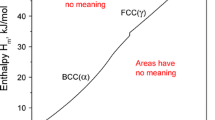Abstract
The EAM potential for liquid thallium was proposed based on the experimental data for the pair correlation function, density, energy, and compressibility at 588 K. The properties of thallium models on the binodal were calculated to temperatures of 3000 K. Good agreement with experiment was obtained for density (to 1200 K), energy (to 3000 K), self-diffusion and viscosity coefficients (to 800 K), and with the existing pair correlation functions (to 973 K). The parameters of the EAM potential that are responsible for highly compressed states were calculated from the form of the shock adiabat of thallium: neglecting the electronic contributions to energy and pressure (EAM-1) and including these contributions using the free electron model (EAM-2). Two corresponding series of models were constructed under shock compression conditions to a pressure of 159 GPa. Inclusion of the electronic contributions lowers the temperature on the shock adiabat at Z = 1.8 by ∼23%. The cold pressure isotherms (at 298 K) calculated with both potentials are in good agreement with each other and with the isotherm of the real static compression of thallium to pressures of 137 GPa. For thallium nanoclusters with sizes from 13 to 5083 atoms, the excess surface energy was calculated, which is lower in the macroscopic limit by 15–20% than the surface tension of real thallium.









Similar content being viewed by others
REFERENCES
W. Schommers, Phys. Lett. A 43, 157 (1973).
D. K. Belashchenko, Liquid Metals. From Interparticle Potentials to the Properties, Shock Compression, Earth’s Core, and Nanoclusters (Nova Science, New York, 2018).
D. K. Belashchenko, Phys. Usp. 56, 1176 (2013).
G. E. Norman and V. V. Stegailov, Math. Models Comput. Simul. 5, 305 (2012).
M. S. Daw and M. I. Baskes, Phys. Rev. B 29, 6443 (1984).
M. I. Baskes, S. P. Chen, and F. J. Cherne, Phys. Rev. B 66, 104107 (2002).
M. J. Assael, I. J. Armyra, J. Brillo, et al., J. Phys. Chem. Ref. Data 41, 033101 (2012).
www.webelements.com.
Thermodynamical Properties of Individual Substances, Ed. by V. P. Glushko (Nauka, Moscow, 1981), Vol. 3 [in Russian].
M. B. Gitis and I. G. Mikhailov, Sov. Phys. Acoust. 12, 14 (1966).
P. N. V’yugov and V. S. Gumenyuk, Ukr. Fiz. Zh. 11, 440 (1966).
A. R. Regel’ and V. M. Glazov, Physical Properties of Electronic Melts (Nauka, Moscow, 1980) [in Russian].
M. Hino, T. Ejima, and M. Kameda, J. Jpn. Inst. Met. 33, 617 (1969).
B. M. Lepinskikh, A. A. Belousov, S. G. Bakhvalov, et al., Transport Properties of Metal and Slag Melts, Reference Book, Ed. by N. A. Vatolin (Metallurgiya, Moscow, 1995) [in Russian].
J. A. Cahill and A. V. Grosse, J. Phys. Chem. 69, 518 (1965).
Y. Waseda, The Structure of Non-Crystalline Materials. Liquids and Amorphous Solids (McGraw-Hill, New York, 1980).
J. Hafner, J. Non-Cryst. Solids 117–118, 18 (1990).
D. K. Belashchenko and O. I. Ostrovskii, Russ. J. Phys. Chem. A 80, 509 (2006).
D. K. Belashchenko, High Temp. 44, 675 (2006).
D. K. Belashchenko, Russ. J. Phys. Chem. A 95, 2375 (2021).
E. Yu. Tonkov and E. G. Ponyatovsky, Phase Transformations of Elements under High Pressure (CRC, Boca Raton, FL, 2005).
D. K. Belashchenko, Phys. Usp. 63, 1161 (2020).
D. K. Belashchenko, Metally, No. 3, 136 (1989);
Metally, No. 1, 166 (1990).
D. K. Belashchenko, Computer Simulation of Liquid and Amorphous Substances (MISIS, Moscow, 2005) [in Russian].
P. J. Daivis and D. J. Evans, J. Chem. Phys. 100, 541 (1994).
S. H. Lee and T. Chang, Bull. Korean Chem. Soc. 24, 1590 (2003).
L. D. Landau and E. M. Lifshitz, Course of Theoretical Physics, Vol. 6: Fluid Mechanics (Nauka, Moscow, 1986; Pergamon, New York, 1987).
J. M. Walsh, M. H. Rice, R. G. McQueen, and F. L. Yarger, Phys. Rev. 108, 196 (1957).
R. G. McQueen and S. P. Marsh, J. Appl. Phys. 31, 1253 (1960).
S. P. Marsh, LASL Shock Hugoniot Data (Univ. California Press, Berkeley, 1980).
http://www.ihed.ras.ru/rusbank/.
K. Kotmoola, B. Lic, S. Chakraborty, et al., Proc. Natl. Acad. Sci. U. S. A. 113, 11143 (2016).
L. D. Landau and E. M. Lifshitz, Course of Theoretical Physics, Vol. 5: Statistical Physics (GITTL, Moscow, 1951; Pergamon, Oxford, 1980).
N. Ozaki, K. A. Tanaka, T. Ono, et al., Phys. Plasmas 11, 1600 (2004).
M. Koenig, E. Henry, G. Huser, et al., Nucl. Fusion 44, S208 (2004).
Z. Qiao, L. Yan, Z. Cao, and Y. Xie, J. Alloys Compd. 325, 180 (2001).
B. Medasani, Y. H. Park, and I. Vasiliev, Phys. Rev. B 75, 235436 (2007).
S. M. Thompson, K. E. Gubbins, J. P. R. B. Walton, et al., J. Chem. Phys. 81, 530 (1984).
D. K. Belashchenko, Russ. J. Phys. Chem. A 89, 516 (2015).
J. R. Vella, F. H. Stillinger, A. Z. Panagiotopoulos, et al., J. Phys. Chem. B 119, 8960 (2015).
J. R. Vella, F. H. Stillinger, A. Z. Panagiotopoulos, et al., Phys. Rev. B 95, 064202 (2017).
A. Adamson, The Physical Chemistry of Surfaces (Wiley, New York, 1976).
Techniques de l’Ingeneur, Traite Constantes physico-chimiques. Influence de temperature sur la tension superficielle, K 476-2.
O. A. Timofeevicheva and V. B. Lazarev, Dokl. Akad. Nauk SSSR 138, 412 (1961).
O. G. Ashkhotov and I. B. Ashkhotova, Russ. J. Phys. Chem. A 93, 2137 (2019).
D. K. Belashchenko, Russ. J. Phys. Chem. A 93, 1093 (2019).
Author information
Authors and Affiliations
Corresponding author
Ethics declarations
The author declares that he has no conflicts of interest.
Additional information
Translated by L. Smolina
Rights and permissions
About this article
Cite this article
Belashchenko, D.K. Molecular Dynamics Simulation of Liquid Thallium. Russ. J. Phys. Chem. 96, 572–583 (2022). https://doi.org/10.1134/S0036024422030074
Received:
Revised:
Accepted:
Published:
Issue Date:
DOI: https://doi.org/10.1134/S0036024422030074




